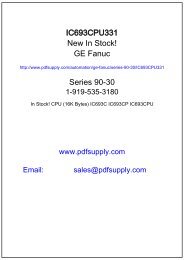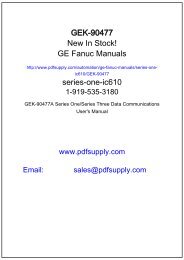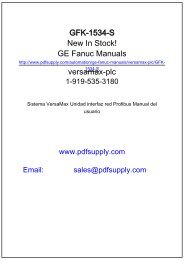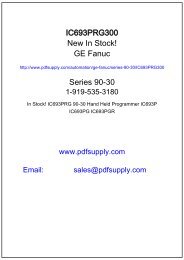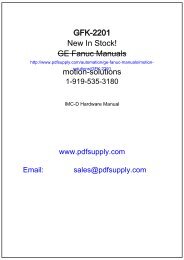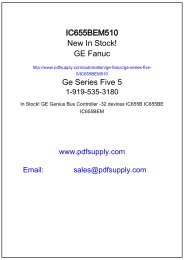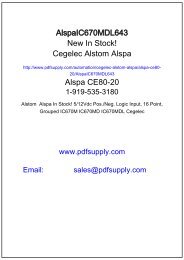- Page 1: AlspaIC693MDL655New In Stock!Cegele
- Page 6 and 7: PrefaceThis manual describes the op
- Page 8 and 9: Preface3. MANUAL NUMBERSIn some cas
- Page 10 and 11: Reader’s commentsALS 52102 c-enAl
- Page 16: Contents5.3.2. Valid Memory Types .
- Page 19 and 20: ContentsAPPENDIX C - INSTRUCTION MN
- Page 21 and 22: TablesTable 2.1 - Sweep Time Contri
- Page 23: Introduction2. FAULT HANDLINGFaults
- Page 27 and 28: IntroductionPage 1-6Alspa C80-35, C
- Page 29 and 30: System Operation1.1. Standard Progr
- Page 31 and 32: System OperationAs shown in the PLC
- Page 33 and 34: System OperationTable 2.3 - I/O Sca
- Page 35 and 36: System Operation1.1.3. Housekeeping
- Page 37 and 38: System Operation1.3. System Communi
- Page 39 and 40: System OperationDue to variations i
- Page 41 and 42: System OperationThe following table
- Page 43 and 44: System Operation2.1.1. Examples of
- Page 45 and 46: System Operation2.1.3. Periodic Sub
- Page 47 and 48: System Operation2.3. Transitions an
- Page 49 and 50: System Operation2.6. System Status
- Page 51 and 52: System Operation2.7. Function Block
- Page 53 and 54: System OperationTimer, counter, BIT
- Page 55 and 56: ÎÎÎÎÎÎÎÎÎÎSystem Operatio
- Page 57 and 58: System Operation4.3. Watchdog Timer
- Page 59 and 60: System Operation5.2. Privilege Leve
- Page 61 and 62: System Operation6. ALSPA C80-35, C8
- Page 63 and 64: System OperationInput/Output Module
- Page 65 and 66: System Operation6.7. Micro PLCsThe
- Page 67 and 68: Fault Explanations and Correction1.
- Page 69 and 70: Fault Explanations and Correction1.
- Page 71 and 72: Fault Explanations and Correction1.
- Page 73 and 74: Fault Explanations and Correction1.
- Page 75 and 76:
Fault Explanations and Correction2.
- Page 77 and 78:
Fault Explanations and Correction2.
- Page 79 and 80:
Fault Explanations and Correction2.
- Page 81 and 82:
Fault Explanations and CorrectionEr
- Page 83 and 84:
Fault Explanations and Correction3.
- Page 85 and 86:
Fault Explanations and CorrectionPa
- Page 87 and 88:
Alspa P8-25/35/05 Instruction Set1.
- Page 89 and 90:
Alspa P8-25/35/05 Instruction Set1.
- Page 91 and 92:
Alspa P8-25/35/05 Instruction Set1.
- Page 93 and 94:
Alspa P8-25/35/05 Instruction Set1.
- Page 95 and 96:
Alspa P8-25/35/05 Instruction SetTh
- Page 97 and 98:
Alspa P8-25/35/05 Instruction Set2.
- Page 99 and 100:
Alspa P8-25/35/05 Instruction Set2.
- Page 101 and 102:
Alspa P8-25/35/05 Instruction Set__
- Page 103 and 104:
Alspa P8-25/35/05 Instruction Set2.
- Page 105 and 106:
Alspa P8-25/35/05 Instruction Set2.
- Page 107 and 108:
Alspa P8-25/35/05 Instruction SetTh
- Page 109 and 110:
Alspa P8-25/35/05 Instruction SetTh
- Page 111 and 112:
Alspa P8-25/35/05 Instruction SetYo
- Page 113 and 114:
Alspa P8-25/35/05 Instruction Set3.
- Page 115 and 116:
Alspa P8-25/35/05 Instruction Set3.
- Page 117 and 118:
Alspa P8-25/35/05 Instruction Set3.
- Page 119 and 120:
Alspa P8-25/35/05 Instruction Set3.
- Page 121 and 122:
Alspa P8-25/35/05 Instruction Set__
- Page 123 and 124:
Alspa P8-25/35/05 Instruction Set4.
- Page 125 and 126:
Alspa P8-25/35/05 Instruction Set5.
- Page 127 and 128:
Alspa P8-25/35/05 Instruction SetTh
- Page 129 and 130:
Alspa P8-25/35/05 Instruction Set5.
- Page 131 and 132:
Alspa P8-25/35/05 Instruction Set5.
- Page 133 and 134:
Alspa P8-25/35/05 Instruction Set5.
- Page 135 and 136:
Alspa P8-25/35/05 Instruction Set5.
- Page 137 and 138:
Alspa P8-25/35/05 Instruction SetEx
- Page 139 and 140:
Alspa P8-25/35/05 Instruction Set5.
- Page 141 and 142:
Alspa P8-25/35/05 Instruction Set5.
- Page 143 and 144:
Alspa P8-25/35/05 Instruction SetEx
- Page 145 and 146:
Alspa P8-25/35/05 Instruction Set6.
- Page 147 and 148:
Alspa P8-25/35/05 Instruction Set6.
- Page 149 and 150:
Alspa P8-25/35/05 Instruction Set6.
- Page 151 and 152:
Alspa P8-25/35/05 Instruction Set6.
- Page 153 and 154:
Alspa P8-25/35/05 Instruction SetEx
- Page 155 and 156:
Alspa P8-25/35/05 Instruction Set__
- Page 157 and 158:
Alspa P8-25/35/05 Instruction Set6.
- Page 159 and 160:
Alspa P8-25/35/05 Instruction Set6.
- Page 161 and 162:
Alspa P8-25/35/05 Instruction Set7.
- Page 163 and 164:
Alspa P8-25/35/05 Instruction SetEx
- Page 165 and 166:
Alspa P8-25/35/05 Instruction SetTh
- Page 167 and 168:
Alspa P8-25/35/05 Instruction Set8.
- Page 169 and 170:
Alspa P8-25/35/05 Instruction Set8.
- Page 171 and 172:
Alspa P8-25/35/05 Instruction Set8.
- Page 173 and 174:
Alspa P8-25/35/05 Instruction Set8.
- Page 175 and 176:
Alspa P8-25/35/05 Instruction Set9.
- Page 177 and 178:
Alspa P8-25/35/05 Instruction Set9.
- Page 179 and 180:
Alspa P8-25/35/05 Instruction Set||
- Page 181 and 182:
Alspa P8-25/35/05 Instruction SetTh
- Page 183 and 184:
Alspa P8-25/35/05 Instruction SetTh
- Page 185 and 186:
Alspa P8-25/35/05 Instruction Set9.
- Page 187 and 188:
Alspa P8-25/35/05 Instruction SetNo
- Page 189 and 190:
Alspa P8-25/35/05 Instruction Set9.
- Page 191 and 192:
Alspa P8-25/35/05 Instruction Set9.
- Page 193 and 194:
Alspa P8-25/35/05 Instruction SetEx
- Page 195 and 196:
Alspa P8-25/35/05 Instruction SetEx
- Page 197 and 198:
Alspa P8-25/35/05 Instruction Set9.
- Page 199 and 200:
Alspa P8-25/35/05 Instruction Set9.
- Page 201 and 202:
Alspa P8-25/35/05 Instruction SetEx
- Page 203 and 204:
Alspa P8-25/35/05 Instruction Set9.
- Page 205 and 206:
Alspa P8-25/35/05 Instruction Set9.
- Page 207 and 208:
Alspa P8-25/35/05 Instruction Set9.
- Page 209 and 210:
Alspa P8-25/35/05 Instruction Set9.
- Page 211 and 212:
Alspa P8-25/35/05 Instruction SetRe
- Page 213 and 214:
Alspa P8-25/35/05 Instruction SetTa
- Page 215 and 216:
Alspa P8-25/35/05 Instruction SetTa
- Page 217 and 218:
Alspa P8-25/35/05 Instruction SetTh
- Page 219 and 220:
Alspa P8-25/35/05 Instruction SetTh
- Page 221 and 222:
Alspa P8-25/35/05 Instruction Set9.
- Page 223 and 224:
Alspa P8-25/35/05 Instruction SetPa
- Page 225 and 226:
Instruction TimingTable A.1 - Instr
- Page 227 and 228:
Instruction TimingTable A.1 - Instr
- Page 229 and 230:
Instruction TimingTable A.1 - Instr
- Page 231 and 232:
Instruction TimingTable A.1 - Instr
- Page 233 and 234:
Interpreting Faults Using Alspa P8-
- Page 235 and 236:
Interpreting Faults Using Alspa P8-
- Page 237 and 238:
Interpreting Faults Using Alspa P8-
- Page 239 and 240:
Interpreting Faults Using Alspa P8-
- Page 241 and 242:
Interpreting Faults Using Alspa P8-
- Page 243 and 244:
Interpreting Faults Using Alspa P8-
- Page 245 and 246:
Instruction MnemonicsFunctionGroupI
- Page 247 and 248:
Key FunctionsAlspa P8 Key Help (ALT
- Page 249 and 250:
Key FunctionsAlspa P8 Instruction M
- Page 251 and 252:
Key FunctionsPage D-6Alspa C80-35,
- Page 253 and 254:
Using Floating-Point NumbersOutside
- Page 255 and 256:
Using Floating-Point Numbers3. ERRO
- Page 257 and 258:
Using Floating-Point NumbersInterna
- Page 259 and 260:
IndexIndex 8 Alspa C80-35, C80-25 a
- Page 261 and 262:
IndexIndex 10 Alspa C80-35, C80-25
- Page 263 and 264:
IndexIndex 12 Alspa C80-35, C80-25
- Page 265 and 266:
IndexIndex 14 Alspa C80-35, C80-25
- Page 267 and 268:
IndexIndex 16 Alspa C80-35, C80-25





